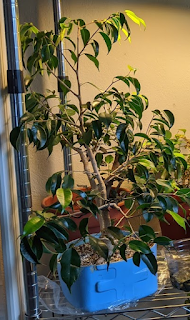The exact origins of this one are unfortunately lost in the murky depths of prehistory... It's likely it started as a branch on the mother of all ficuses that this greenhorn has had for 12 years or so. Having been clipped off the mother tree, it likely was rooted in water and then potted up. And perhaps during the rooting process or a little later, it was deemed interesting to grow some aerial roots on it, and the tree obliged with three.
Around the 2019 vernal equinox, it got repotted into a special, custom made pre-bonsai training pot (Kirkland detergent can cut in half, holes drilled, and spray painted UN peace keeper blue).

In search of a decent nebari, one of the rear roots was bent around and brought to the front from under the trunk. If this works, it'll be quite a coup.
The potential of this tree to be a twin trunk classic (a la Peter Chan's famous Japanese Maple) wasn't lost on the novice. So some wiring was done to get the criss-crossing branches out of the way, and still make it all look pleasing to the eye.
And then the tree was generally ignored, as it basically did nothing interesting for an year.
In the winter of 2019, it was brought indoors and kept under artificial lights. And there, after a while, the tree finally seemed to decide it might just want to grow a few new leaves after all.
Forced to spend all waking hours with this tree, thanks to the great pandemic of 2019, the tyro stopped ignoring it, and started to rather appreciate it. Accordingly, it was determined that the tree deserved a promotion to a new pot - another custom made beauty! (A $1 plastic box spray painted black. That lucky tree!)
Cinco de Mayo de 2020 had just passed, but this time the invader was still winning. By now, one of the aerial roots in the front of the tree had taken a rather undesirable turn, lapping over the other one and heading in the wrong direction, spoiling the radial symmetry that's desirable in the nebari. So that one had to go. Adios. Upon more inspection of the root mass, two other rather thick ones were noticed and with only a slight hesitation, were cut off as well.

So, this tree didn't have a good day. It lost a good chunk of its roots. All for what, a silly new plastic pot? Wait tree, you will in time realize it was not only not so bad, it was in fact a great day. So believes the neophyte, anyway.

Back under the familiar CFL and LED lights, having lost many roots but gained a $1 pot and some fancy new soil mix (lava rock, Napa oil dry product, sand, MiracleGro potting mix, perlite, Osmocote slow release fertilizer), sits majestically this Ficus Benjamina. Only time will tell if the root loss results in any foliage loss.
The rookie hopes not.
And oh by the way, that hopeful nebari experiment turned out to be a failed coup - no sign of that root was to be found. Oh well.
End of August, Post Covid era, year #1 update. Absolutely no foliage loss after the brutal root pruning back in May! The tree has been almost entirely sitting in artificial light, since the estudiant
é didn't want to risk the root deprived tree in the summer sun and occasional winds. So it did some slow growing. But it has been apparent it's getting a bit too leggy, and the top need to be trimmed. After agonizing about it
for weeks, the pupil became decisive on a late August Sunday afternoon. And the result is not so bad...
The vision the padawan has in mind for this tree is like so:

































